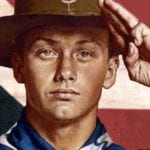 Mysteries
Mysteries  Mysteries
Mysteries  History
History 10 Surprising Stories About the Texas Rangers
 Humans
Humans 10 Philosophers Who Were Driven Mad by Their Own Theories
 Miscellaneous
Miscellaneous 10 Video-Game-Worthy Weapons and Armors from History
 Weird Stuff
Weird Stuff 10 Psychics Who Accurately Predicted Wartime Events
 The Arts
The Arts 10 Pieces of Art Inspired by a Broken Heart
 Health
Health 10 Science Fiction-Sounding New Medical Treatments
 History
History 10 Surprising Facts About the Father of Submarine Warfare
 Space
Space Ten Astonishing New Insights into Alien Worlds
 Weird Stuff
Weird Stuff 10 Bizarre Summer Solstice Rituals Still Practiced Today
 Mysteries
Mysteries Top 10 Haunting Facts About the Ghost Ship MV Alta
 History
History 10 Surprising Stories About the Texas Rangers
 Humans
Humans 10 Philosophers Who Were Driven Mad by Their Own Theories
Who's Behind Listverse?

Jamie Frater
Head Editor
Jamie founded Listverse due to an insatiable desire to share fascinating, obscure, and bizarre facts. He has been a guest speaker on numerous national radio and television stations and is a five time published author.
More About Us Miscellaneous
Miscellaneous 10 Video-Game-Worthy Weapons and Armors from History
 Weird Stuff
Weird Stuff 10 Psychics Who Accurately Predicted Wartime Events
 The Arts
The Arts 10 Pieces of Art Inspired by a Broken Heart
 Health
Health 10 Science Fiction-Sounding New Medical Treatments
 History
History 10 Surprising Facts About the Father of Submarine Warfare
 Space
Space Ten Astonishing New Insights into Alien Worlds
 Weird Stuff
Weird Stuff 10 Bizarre Summer Solstice Rituals Still Practiced Today
10 Origins Of Rock-And-Roll Oldies But Goodies
Rock stars are popular. Many of them can fill athletic stadiums with crowds of devotees eager to hear them perform live. Understandably, their fans are also often curious about where their idols got their ideas for the hit songs they wrote. Especially during the 1960s and the 1970s, rock and roll, country and western, blues, and other genres of popular music were truly original, innovative, and creative.
No outstanding singer or band sounded like any other; each was distinctive; each was unique, offering his, her, or their own sounds. This is one of the characteristics of the musicians of those decades that made them famous among established and new fans generation after generation. Here are 10 origins of 1960s-1970s rock-and-roll oldies but goodies that continue to rock the house.
10 “Take It to the Limit”
Randy Meisner, a founding member of The Eagles, not only played the bass guitar and sang, but he also wrote songs for the group—or, in many cases, parts of songs. As Meisner explains, although he had started the band’s hit “Take It to the Limit,” the song remained unfinished when it was time to record it, and the band’s fellow founders Glenn Frey (1948-2016) and Don Henley came to the rescue by filling “in the blanks” in the lyrics.
The experience of feeling that he had seen it all and done it all inspired the words “take it to the limit.” The words were intended to express not only his worldliness and ennui, but also the feeling of “getting old.” The song is also meant to express the need or the tendency that one has, despite such feelings, to “just keep punching away” each day, to continue to “take it to the limit one more time.”
9 “Bad Moon Rising”
A movie—and a musician’s fear of hurricanes—inspired Creedence Clearwater Revival’s John Fogerty to pen the lines of “Bad Moon Rising.” The film was The Devil and Daniel Webster (1941). One of the movie’s scenes in particular got under Fogerty’s skin, he explained: the hurricane footage prompted the lyrics “I hear hurricanes a-blowing/ I know the end is coming soon.”
To Fogerty, the thought of “rivers overflowing” due to the effects of the storm sounded like “the voice of rage and ruin,” which encourages the song’s warning, “Don’t go out tonight/ Well, it’s bound to take your life.”
Sometimes, audiences heard “there’s a bathroom on the right,” instead of “There’s a bad moon on the rise, all right,” which, on occasion, amused Fogerty enough to substitute the misunderstood words for those he had written.
8 “Me and Bobby McGee”
“Me and Bobby McGee” is one of the many songs made famous by the legendary blues artist Janis Joplin (1943-1970). (Her group, Full Tilt Boogie Band, might have helped a little.) Joplin’s ability to infuse the words to a song with powerful, raw emotion, especially deep sadness, despite her loud, often shrill interpretations of the lyrics’ narrative, electrified audiences. Like other superstars of the music world, there was no mistaking her voice; Joplin’s vocals, like her style, were unique.
Although she is more subdued in singing “Me and Bobby McGee” than she tends to be in many other songs, she still taps the emotions of her listeners, drawing them into the pathos and loss expressed by the song, which recounts a couple of drifters’ hitchhiking journey from Baton Rouge, Louisiana, to Salinas, California, and includes the lament concerning the woman’s having let Bobby “slip away.” She would exchange her entire future, the woman says, for one day of the past, when she was close to Bobby.
The song was not released until after Joplin’s death; upon its appearance, in 1971, it soared to the top of the charts. Joplin did not write the song, though; legendary musician Kris Kristofferson and songwriter Fred Foster (1931-2019) are its authors. Kristofferson also sang the tune, as did such other luminaries as Waylon Jennings (1937-2002), the Grateful Dead, Loretta Lynn, Kenny Rogers (1938-2020) and The First Edition, Gordon Lightfoot, Dolly Parton, Miranda Lambert, Olivia Newton-John, Vicki Britton, and Johnny Cash (1932-2003).
Of all the performances by others who sang the song, though, Kristofferson seems to have preferred Joplin’s rendition. In his own words, he described the effect of hearing her performance for the first time. “The first time I heard Janis Joplin’s version was right after she died. . . . Afterwards, I walked all over L. A., just in tears. I couldn’t listen to the song without really breaking up.” The song always reminded him of her: “Every time I sing it, I still think of Janis.”
The idea for the ballad was that of Monument Records founder and producer Fred Foster, who said the clincher was that the song was about a woman: “Bobby McKee is a she.” Kristofferson, who mistook “McGee” for “McKee,” says he had “never written a song on assignment,” but agreed to take Foster’s suggestion under advisement.
The rhythm of another song, “Why You Been Gone So Long” by Mickey Newbury (1940-2002) suggested the meter for “Me and Bobby McGee,” and the Federico Fellini (1920-1993) movie La Strada (1954) gave Kristofferson the idea for the theme of the song.
In Fellini’s movie, a motorcyclist abandons his girlfriend alongside the road. Years later, encountering another woman as she plays a song on the trombone that his girlfriend had played when they were together years before, the motorcyclist asks her where she heard the song. A young woman who appeared out of nowhere and later died, unknown, used to sing it, she says.
“To me,” Kristofferson says, “that was the feeling at the end of ‘Bobby McGee.’ The two-edged sword that freedom is. He was free when he left the girl, but it destroyed him. That’s where the line ‘Freedom’s just another name for nothing left to lose’ came from.”
Joplin herself made one other change to Kristofferson’s song. He had turned Bobby into a woman; she transformed him back into a man.
7 “Ball and Chain”
Joplin also captivated audiences with her rendition of “Ball and Chain” (1968), a song about a problematic romantic relationship. Her vocals, full of anguish, reveal the tortured soul of a woman in love who isn’t certain that her feelings are fully reciprocated. One can hear, in Joplin’s wails and cries, the agony of doubt and the struggle of a woman to come to terms with a disintegrating, possibly terminated, relationship.
As in the case of “Me and Bobby McGee,” this song, although popularized by Joplin’s version of it, was written by another musician, blues phenomenon Willie Mae (“Big Mama”) Thornton (1926-1984), whom Joplin regarded as a mentor of sorts.
Although “Ball and Chain” was not the runaway hit for Thornton as it proved to be for Joplin two years after Thornton sang the song, Thornton’s rendition also thrilled audiences. In fact, some reviewers favored Thornton’s performance over that of Joplin. According to Notable Black American Women, Book II, edited by Jessie Carney Smith, “Joplin’s performance was always cultivated and labored, [whereas] Thornton’s is straight from the heart with a punch to the belly [and] always contains an element of danger.”
During a 1979 performance, Thornton, then ailing, performed the song as part of her appearance at the San Francisco Blues Festival, where, according to reviewer Richard Cohen, it was the “highlight of her set,” during which she “sang, moaned, yelled, and did about everything there is to do to a song” and was rewarded by a standing ovation.
6 “Lather”
In her autobiography, Somebody to Love?: A Rock-and-Roll Memoir, written with Andrea Cagan, Grace Slick recounts the origin of her song “Lather” (1968). After a romantic night with her “lover,” Jefferson Airplane drummer Spencer Dryden (1938-2005), she wrote the song as an expression, from the perspective of “perpetual children,” of a couple’s anticipation of reaching “the impending age of thirty.”
Some of Dryden’s personality appears to have been included in the song’s description of Lather. Although, Slick writes, he had “sadness in his eyes, he laughed easily,” and Lather seems partly sad and partly amused as, in the song, he looks at his companion, his “eyes wide and plainly [says], ‘Is it true that I’m no longer young?’” At the same time, the song itself has a melancholic tone appropriate to young people’s apprehension of the truth that youth is not an eternal state.
5 “Riders on the Storm”
Soft and melodic, with piano notes and raindrops, “Riders on the Storm” (1971), is characterized as a “mesmerising seven-minute epic.” The songwriting was a collaborative effort in which Robbie Krieger, the Doors’s guitarist, and Jim Morrison (1943-1971), the band’s charismatic vocalist, were riffing on actor-songwriter Stan Jones’s country-and-western song, “Riders in the Sky: A Cowboy Legend.” Keyboardist Ray Manzarek (1939-2013) “proposed the bassline and piano part” and the song’s “jazzy style.”
Morrison had already worked out the narrative about a serial killer who is also more than simply a hitchhiking murderer. As Manzarek explained, “Jim . . . didn’t want to complete the song just about a killer hitchhiker.” The song’s final verse suggests that, although the victim no longer occupies her body, her “essential life will never end, and love is the answer to all things. It gives the song a different perspective.” At the time the song was written, its song’s central character, he adds, “was way ahead of his time.”
4 “Purple Haze”
The music for “Purple Haze” (1967) by Jimi Hendrix (1942-1970) is a mix of effects, point out Harry Shapiro and Caesar Glebbeek, authors of Jimmy Hendrix: Electric Gypsy, and includes “open-string techniques, . . . flattened fifth intervals, hammer-ons, and pull-offs in single-note runs creating modal sounds and the famous ‘Hendrix Chord’—the sharpened ninth,” which, together, contribute to its “dirty, raw metallic, angular sounds.”
The song’s lyrics, “written upstairs in [a club’s] dressing room, included “about a thousand words,” Hendrix said, as he implied, with displeasure, that their number had been cut, a charge that producer Chas Chandler (1938-1996) denied, although he admitted that, in general, lyrics to Hendrix’s other songs were fairly frequently “edited down.” While Hendrix did not see the need to keep songs short and “tended” to write songs that were “six or seven minutes” long, they were often shortened to half such lengths during production, which Chandler and his associates considered to be improvements. Although one of the song’s lines reads, “’Scuse me while I kiss the sky,” during concerts, Hendrix would sometimes playfully change “the sky” to “this guy,” indicating drummer Mitch Mitchell.
Although many see the song as a more-or-less disguised description of an LSD experience, Shapiro and Glebbeek are disinclined to view it as such. The song’s existing lines are, according to Hendrix, merely part of a much longer set of lyrics, so interpretation as to their meaning is problematic, especially since Hendrix provided a different answer each time he was asked about the song’s origin.
In addition, such a reading would not account for the sources that Hendrix claimed as inspirations, including a dream he had during which he “was walking under the sea,” an experience he had had with “a girl who tried to ensnare him with voodoo during his early . . . days,” other “real-life experiences,” “images and themes” from mythology and science fiction books he had read, and “allegorical interpretations” of historical events involving migrations of “prehistoric tribes” and Hopi tales of Spider-Woman, their equivalent of Eve, who was “born in water” under diffused light that resembled, to her children, “a Purple Haze.”
3 “I Will Always Love You”
The many projects and pursuits of multi-talented country music great Dolly Parton include singing, playing musical instruments, and writing songs, one of which, “I Will Always Love You,” won acclaim not only for her, but also for Whitney Houston (1963-2012), the latter’s version of the hit being preferred by many, including Parton herself.
Composed as a farewell song for Porter Wagoner (1927-2007), Parton’s mentor and business partner, after Parton struck out on her own at age twenty-eight, the song did well when she sang it in 1972, but she must have known for certain what a huge hit she had on her hands when Elvis Presley (1935-1977) asked her permission to record his version of her song. Unfortunately, Presley’s manager, Tom Parker (1909-1997), presented terms that would be a deal-breaker for Parton, insisting that Presley “take half the publishing.”
A decade later, in 1982, Parton re-recorded the song, and it again topped the charts. Ten years later, it shot to the top again, and stayed there for months, when Whitney Houston, putting a romantic spin on the lyrics, sang the song on the soundtrack of The Bodyguard, in which she starred, opposite Kevin Costner.
2 “I Want to Hold Your Hand”
The Beatles would rock the world with songs like “Michelle” (1965), “Nowhere Man” (1966), “Eleanor Rigby” (1966), “Penny Lane” (1967), “Strawberry Fields Forever” (1967), “All You Need Is Love” (1967), “Lucy in the Sky with Diamonds” (1967), “Lady Madonna” (1968), “Hey, Jude” (1968), “Revolution” (1968), “Get Back” (1969), “A Day in the Life” (1978), and a host of other hits. The band’s ten-year career began with a simple song, though, “I Want to Hold Your Hand” (released in England in 1960).
What’s the story behind the song that launched the career of one of the most famous rock-and-roll groups of all time? According to The Billboard Book of Number 1 Hits, by Fred Bronson, although The Beatles were a hit in England, as late as 1963, the band just didn’t seem, to their manager, Brian Epstein (1934-1967), to be gaining any traction in the United States. Epstein had been trying to generate some interest in the band with Capitol Records, but the company’s executives saw no future for the mopheads in the United States: “We don’t think the Beatles will do anything in this market,” they told him, as they passed on the offer of releasing the band’s singles.
Paul McCartney and John Lennon (1940-1980), who had written “I Want to Hold Your Hand” in the basement of the home of McCartney’s girlfriend, actress Jane Asher, wrote it specifically for American release, giving it a “gospel sound.” Epstein “took a demo copy” to New York the day after The Beatles had given a command performance for the Queen Mother. Capitol’s director of eastern operations, Brown Meggs (1930-1997), liked what he heard and scheduled a January 13, 1964, release of the song. During the trip, the manager also met with a talent scout, who arranged for the band to play on two American telecasts.
However, WWDC Radio in Washington, DC, beat both the record company and NBC’s The Jack Paar Program to the punch, broadcasting a copy of “I Want to Hold Your Hand” that the station had acquired from a BOAC flight attendant. Public response was overwhelmingly favorable, and Capitol changed the release date to December 26. The recording shot to the top of the charts, selling 15 million copies worldwide. The Beatles had finally become an “overnight success” in the United States.
1 “Concentration Moon”
For the irreverent prankster Frank Zappa (1940-1993), sacred cows did not exist. Any sort of hypocrisy, pretentiousness, humbug, or other tomfoolery was an acceptable target for his lyrics, as suggested by The Mothers of Invention’s album We’re Only in It for the Money (1968), the cover of which is itself a parody of the Beatles’s Sgt. Pepper’s Lonely Hearts Club Band album (1967).
During the 1960s and 1970s, Zappa saw problems and dangers on both the side of the conservative state and on the side of its freewheeling challengers. The album does not seek to strike a balance, or compromise, between them as much as it points out the limitations and perils of both.
Each of the songs in the album targets some aspect of the counterculture or the hippie lifestyle or the mainstream culture against which it supposedly rebels. “Who Needs the Peace Corps” attacks “phony hippies”; “Mom & Dad” indicts social authorities such as police and government officials, but also parents; “Bow-Tie Daddy” satirizes absentee, workaholic fathers; although “Harry, You’re a Beast” has been seen as misogynistic, it can also be viewed as a condemnation of sexist attitudes and “male privilege”; other songs assail other shortcomings and abuses of both the dominant culture and the counterculture.
One of these songs is “Concentration Moon,” which is based on the conspiracy theory that President Ronald Reagan (1911-2004) planned to incarcerate hippies in the camps that were used to imprison Japanese-American citizens during World War II.
According to Kelly Fischer Lowe, author of The Words and Music of Frank Zappa, the song “tells this story in a silly, beer-hall sing-along style, complete with piano-playing stylings and a pseudo brass band playing in the background.” This song, which is directed against “the creeping authoritarianism of the state” that Zappa feared he was witnessing, is a direct condemnation of such tactics, which “counter . . . every part of Zappa’s ideological makeup.”
About The Author: An English instructor at the University of Nevada Las Vegas, Gary L. Pullman, a regular contributor to Listverse, lives south of Area 51, which, according to his family and friends, explains “a lot.” His five-book series, An Adventure of the Old West, is available on Amazon.








